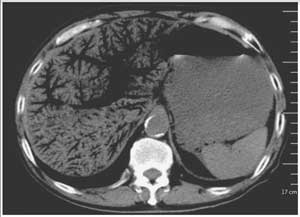- Home
- Editorial
- News
- Practice Guidelines
- Anesthesiology Guidelines
- Cancer Guidelines
- Cardiac Sciences Guidelines
- Critical Care Guidelines
- Dentistry Guidelines
- Dermatology Guidelines
- Diabetes and Endo Guidelines
- Diagnostics Guidelines
- ENT Guidelines
- Featured Practice Guidelines
- Gastroenterology Guidelines
- Geriatrics Guidelines
- Medicine Guidelines
- Nephrology Guidelines
- Neurosciences Guidelines
- Obs and Gynae Guidelines
- Ophthalmology Guidelines
- Orthopaedics Guidelines
- Paediatrics Guidelines
- Psychiatry Guidelines
- Pulmonology Guidelines
- Radiology Guidelines
- Surgery Guidelines
- Urology Guidelines
A case of portal venous gas in man presented with abdominal pain: NEJM Case Study

A case report published in The New England Journal of Medicine describes the case of a 72-year-old man with abdominal pain and an inability to pass flatus from last 11 hours, which later turned out to be portal venous gas -- an accumulation of gas in the portal vein and its branches. This resulted in his death merely 2 hours after presentation.
"A 72-year-old man presented to the emergency department with an 11-hour history of periumbilical abdominal pain and an inability to pass flatus. His medical history included chronic lymphocytic leukemia (for which he had been taking ibrutinib), type 2 diabetes, and chronic hepatitis B virus infection. The pulse was 155 beats per minute, and the blood pressure 83/52 mm Hg," reports Ming Cui and Xin Lu from Peking Union Medical College Hospital, Beijing, China.
On physical examination, his abdomen was diffusely tender, with the most severe pain in the right upper quadrant. Initial laboratory studies of the blood revealed a white-cell count of 22,570 per cubic millimeter (reference range, 4000 to 10,000), an arterial blood pH of 7.27 (reference range, 7.35 to 7.45), and a lactate level of 8 mmol per liter (72 mg per deciliter) (reference range, 0.5 to 1.7 mmol per liter [4.5 to 15.3 mg per deciliter]). Computed tomography of the abdomen revealed extensive portal venous gas, as well as gas in the bowel wall, which had an appearance consistent with ischemic bowel.
Portal venous gas is most commonly associated with bowel ischemia and is a poor prognostic sign in patients with that condition; however, it can also develop in patients with other conditions, such as infection or inflammatory bowel disease, or as a result of an interventional procedure. Treatment was initiated with fluid resuscitation, broad-spectrum intravenous antibiotics, and vasopressors, and an urgent laparotomy was planned. However, the patient’s clinical condition deteriorated rapidly, and he died 2 hours after presentation.
For more details click on the link: DOI: 10.1056/NEJMicm1806082

Disclaimer: This site is primarily intended for healthcare professionals. Any content/information on this website does not replace the advice of medical and/or health professionals and should not be construed as medical/diagnostic advice/endorsement or prescription. Use of this site is subject to our terms of use, privacy policy, advertisement policy. © 2020 Minerva Medical Treatment Pvt Ltd